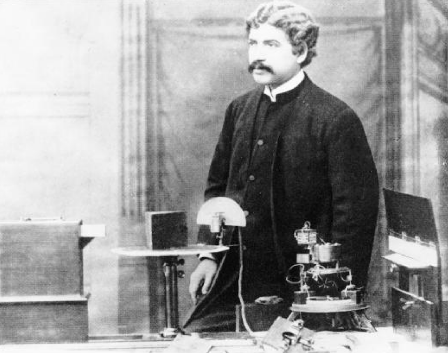Founder: Sir J C Bose
Related: History, museum, instruments, gallery, Darjeeling museum, media
Bose Institute was set up in 1917 by Sir Jagadish Chandra Bose (1858 - 1937), the founder of modern science in the Indian subcontinent. It is Asia's first modern research centre devoted to interdisciplinary research and bears a century old tradition of research excellence. As outlined below, the scientific contributions of Acharya J.C. Bose in both physical and biological sciences are colossal. Even the most eminent of scientists would find it hard to match his strides, spanning various disciplines. Remarkably, these were realised under the colonial yoke amidst severe constraints and well-documented instances of racism. Bose’s Galena detector was the first semiconductor device and photovoltaic cell, whose significance was not missed by Walter Brattain, Nobel laureate in physics [1]. Sir Neville Mott, another Nobel laureate, noted … "J.C. Bose was at least 60 years ahead of his time" and "In fact, he had anticipated the existence of P-type and N-type semiconductors" [2]. He also designed the earliest waveguide and Horn Antenna, an integral part of present day microwave engineering and astronomy. | hhh, |
Sir J.C. Bose demonstrating his wireless millimetre wave (microwave) experiments at the Royal Institution, London in January 1897. This predates the wireless experiments at Salisbury Plain [3, 4] in May 1897 by Marconi, to whom the Nobel prize was however awarded. |
He was the first Asian to be awarded a US patent (No. 755840) in 1904. Bose and the legendary mathematician Ramanujam were also the first Asian fellows of the Royal Society, London as well as those of Vienna and Finland. Bose has been recognised by IEEE as a father of radio and wireless communication. His work was also commemorated by IEEE as the oldest "milestone achievement" from Asia. He was a member from Asia on the International Committee on Intellectual Cooperation of the League of Nations along with Einstein, Curie and Millikan. The Indian Botanic Garden at Shibpur was renamed in his honour in 2009. A crater on the moon is named after him.
Besides being a physicist par excellence, another remarkable contribution of J. C. Bose was that he was the first in the world to initiate interdisciplinary research by probing plants from the vantage point of physics - an integrated biophysical view of life that is in vogue. His studies on coherer led to the discovery of the common nature of the electric response to external stimuli by both living and inanimate objects. He pioneered the understanding of electrical and mechanical responses to stimulation, the transmission of excitation in plant and animal tissues and in vision and memory. Many of these experiments were possible because of his design and fabrication of novel instruments like crescograph, photosynthetic bubbler, soshnugraph etc. All of these were made in India and some at Bose Institute. Two of his famous books are “Response in the Living and Non-Living” (1902) and “The Nervous Mechanism of Plants” (1926). The latter book was dedicated to his friend the great poet and Asia's first Nobel laureate, Rabindranath Tagore. Tagore's great admiration of Bose reflects in his poems.
Lavish appreciations of his work by contemporary giants like Lord Kelvin, Sir William Ramsay, Sir George Stokes, Aldous Huxley, Alfred Cornu (President of the French Academy of Sciences, Paris) and Lord Lister (President of the Royal Society, London) are well recorded.
He is also considered the father of Bengali science fiction.
On his 158'th birthday, coinciding with the centenary of Bose Institute; his timeless legacy was honoured in a doodle by the popular search engine, Google.
| rrr |
Following is a brief timeline of his scientific activities. 1894 - 1899: Created radio-waves as short as 5mm. Such waves are now better known as microwaves and are used in radars, ground and satellite communication, remote sensing and microwave ovens. Also devised a portable apparatus (10" x 12") for the study of their optical properties. It had the earliest waveguide and horn antenna of today’s microwave engineering. Most notably, in 1895, he was the first to demonstrate the wireless transmission and reception of electromagnetic waves at Presidency College (now Presidency University), Kolkata. These waves had a frequency of 60 GHz and travelled a distance of over 23 meters. A plaque from IEEE, immortalising this landmark achievement exists today at Presidency University, Kolkata.
Indeed, Bose was a pioneer of multimedia communication in every way. 1899 - 1902: Initiated detailed study of coherer leading to his discovery of the common nature of the electrical response to all forms of stimulation, in animal and plant tissues as well as in some inorganic models. In 1900, his paper titled "On the Similarity of Responses in Inorganic and Living Matter" at the International Congress of Physics, Paris garnered huge appreciation. |
References:
[1] G.L. Pearson, and W.H. Brattain, "History of Semiconductor Research," Proc. IRE, 43, 1794-1806 (1955)
[2] B. Mitra, "Early Microwave Engineering: J. C. Bose's Physical Researches during 1895-1900," Science and Culture, vol.50, pp.147-154 (1984).
[3] D. T. Emerson, The work of Jagadis Chandra Bose: 100 Years of MM-Wave Research, IEEE Transactions on Microwave Theory and Techniques, 45, 2267-2273 (1997)
[4] J.C. Bose, Collected Physical Papers. Longmans, Green and Co., New York (1927)






















